Planting a lot of Trees.
1200 to be precise. A mixture of hazel (900), english oak (150) and sessile oak (150). This is the first step in restoring my woodland back to oak standards and hazel coppice.
I neglected the woodland last year. When you spend your week working in other peoples woodlands you lose the drive to spend your spare time working your own – sitting down, rather than working the weekend, always feels like a nicer option. That was pretty much the story from last year. However this year, especially with the mental space that I’ve created since I stopped spending all my free time preparing classroom material, I’ve spent a lot of time in the woodland. Specifically planting trees as part of the effort to return to the woodland to a functioning hazel coppice with oak standards.
I started off planting full of joy, but by week six and 1100 trees later, the joy had “morphed into slog”. Here’s a photo of roundabout tree 1092 that Mrs Treesandcode took. Yes, it was staged, but I tried to emulate the correct emotion.
But why plant trees in an established woodland…
Don’t trees just grow naturally?
Yes, they do. But it is more complicated than that. England has a deer problem in that population levels are the highest they’ve been for 1000 years. Deers eat (technically called “browsing”) foliage and saplings. In my woodland that means by the time a sapling has sprouted, it has about one month before a deer comes along and munches off the most important part of the sapling - the apical meristem.
If you ever visit my woodland (and I know some of the readers do on an almost daily basis) you’ll notice something that cannot be unseen once you’ve noticed it – there are very few, if any oak trees younger than 20 years. The reason for this is that up until 20 years ago the woodland was managed for deer and was kept stocked with pheasants. Basically, it was a shooters paradise. That meant there was very little deer pressure on natural regeneration and as a result, trees naturally grew.
However that changed when woodlands4sale purchased the site and parcelled it up. Whilst they may have done some management in terms of trees and infrastructure they stopped allowing the local shoots. That meant the deer returned and population levels went through the roof. There is now enough food for deers to eat, but the price is that natural regeneration has ceased and the woodland is technically in decline. Easy fixed, because of the early stages, but decline none the less.
The solution to this decline is that the deer must be managed - and to avoid confusion, by managed I mean killed and butchered. The aim is not to eliminate the population, but rather reduce the population to a level that allows trees to natural regenerate. Deer management is a complex subject and people have varied opinions on it and so in my woodland, it won’t happen any time soon.
So until the deer problem is sorted, that’s why we plant trees and thats why those trees are covered in tree guards.
Coppice & Standards
The Coppice
If you’re not familiar with coppicing you’d be forgiven as it has fallen out of fashion. Until the early 1900’s most of the materials used in any household came from a coppice. In many senses it was the original “Screwfix”. Hazel, willow, alder, ash, oak, sweet chestnut and a few other species can all be used for coppice.
It is making a comeback because it is the only method of silviculture that adds to bio-diversity. The general idea is you plant a tree of a suitable species in my case Hazel (Corylus avellana) and allow it to establish itself to a “young” age. “Young” is a technical tree survey term used in age classification which means “not sapling and has a lot of growth to do before it reaches its maximum height. Hazel should be about 9 - 10 years old. Then, you fell it right at the ground level. Behold my sketch.
It is important to note that most trees species don’t appreciate being felled and for the most part it kills the tree. However coppice species respond with a “can do” attitude and throw out “epicormic shoots” (water sprouts to some folk). The shoots are the product and are called “rods”. Depending on what you want the rods for, you will grow them for a number of years. If you’re using the rods for making weavers or for binders in hedge laying then you’d probably want a 3-4 year “rotation”. When the rods are at the diameter you want, you “coppice” them and the cycle starts all over again.
In coppice land, the stump is referred to as “the stool” and over the course of time, the stools grow in size. Coppicing also dramatically increases the lifespan of the tree. Hazel would normally last for 50-80 years at a push, but when it is coppiced it could easily last upwards of a few hundred. It would be realistic to expect quality harvests from years 15 onwards. You see this extension in life in all coppiced trees. Ash jumps from 300 years as a tree, to 800+ years as a coppice species. It’s an amazing technique and the ultimate in pragmatic sustainability.
But what about the standards?
The standards
A woodland has four layers. The ground (0-10cm), the field (10cm - 2m), the understory (2-7m) and the canopy (7m+). Hazel is an understory species and when in coppice configuration is quite densely packed to ensure rods grow straight, upwards and toward the light.
In a standards with coppice arrangement, the standards are the larger trees that occupy the canopy layer. In my case that’s going to be oak, specifically a mixture of english oak (Quercus robur) and sessile oak (Quercus patraea). A curious point of note here, if you’re familiar with the phrase “keeping up standards” then you may be interested to know that woodland folklore claims this phrase as its own. To “keep up standards” literally refers to the fact that the best examples should be aimed for and left standing - in other words “keeping them up”. I don’t have any evidence of this beyond my original treeschool woodland teacher. It sounds good though, so I’m sharing it. Maybe it’s misinformation?
Wherever the phrase came from, standards are left standing well into maturity and were traditionally felled and sold once in a while. The general idea being that a local carpenter would come along and pay for a standards and leave them standing until he (yes, “he”, because "she” typically wasn’t a carpenter back in the day) was within a few years of needing them. Leaving the tree standing meant that it was also growing, which meant your return on investment was larger.
There are already a few "lovely standards” in my woodland. It is hard to see but the oak in the middle of this photo is an excellent standard. To the point where I’ve established an amenity area around it called “the pavilion”. If you look hard to the centre right you’ll also see the first chunky oak beams that are going to be used to erect “the pavilion” so that I have somewhere dry to work when I’m in the woodland doing forestry work.
The problem however, is that I don’t have enough standards growing. Deer pressure has suppressed natural regeneration for 20 years on the oaks and grey squirrel pressure has limited the ability of the hazelnuts to actually hit the ground in a state ready for germinating. The birch are beginning to fail which leaves open glades like the one above. As I said above, the woodland is in decline.
I need a lot more standards and I need to establish some clear boundaries.
Boundaries
It would be tempting to rush straight in and start planting up hazels in coppice formation and standards every 10 meters, but that would be a folly. For one, the woodland doesn’t have any clear boundaries beyond stakes in the ground that divide the plots up.
This is a concern for a two reasons. Firstly, motorbikes. We get a lot of tresspassing motorbikes coming through the place. I don’t mind the public walking through the place as long as they enter with good intentions and take only photographs. Motorbikes on the other hand just mash the place up. Tracks, saplings, ground flora all get mashed up by the wheels. Secondly, each of us owners have different approaches to management. Some prefer to do nothing and leave their plots to the whims of nature (spoiler: windfallen birch) others (such as me) are seeking to get the woodland into a workable productive silviculture. A boundary makes it clear where one management system starts and where another begins.
So instead of planting up the coppice, I’ve been planting up the tree stock on the boundaries as a hedge. The hazel is 1m apart with oaks every fifteen meters placed 1-3 meters behind the hedge.

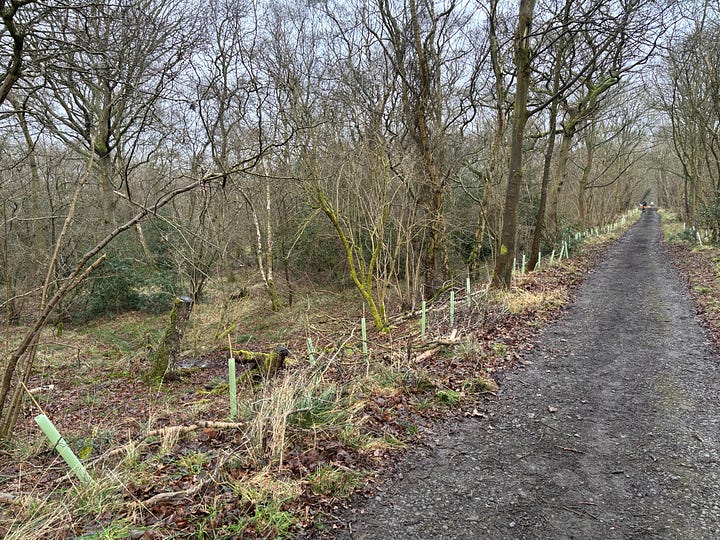

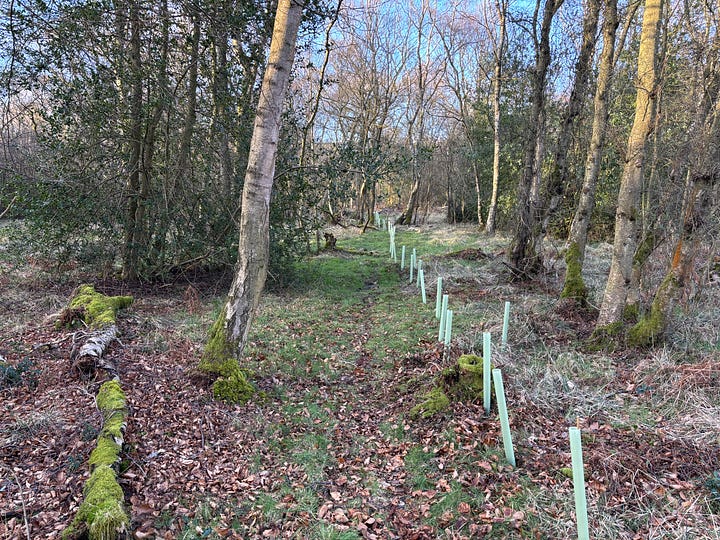
I’ll be adding to the hedge every year, next year I’ll beat it up (woodland term for replacing the dead trees) and thicken it with hawthorn and blackthorn. Nasty pointy thorns are an excellent natural repellent for motorised trespassers and do a great job of keeping people in certain places. After ten years or so it should be ready to be laid and fortunately for me, the required hazel stock for stakes and binders can be sourced from my own resources.
I’m aiming for something like this - to be clear - this is a random hedge off the internet. I didn’t do it, I don’t own it and it isn’t in the woodland. But it is lovely.

Planting
It has taken a while to get these trees in the ground (and I still have 60 or so left to do). Often I’m working alone and isn’t like the planting I’ve done before at The Estate. Here I have to manually carry the trees through a woodland (slow), knock the supports in about 20cm, pop a rabbit tube on the cane and then lay out trees on each. Then I walk back to the start of my line (which could be 20 or 180 trees) and then make a hole, insert the tree, carefully put the tree guard over the tree, making sure not to strip the buds off with the tube edge and then finally whack the stake level with the top of the guard. Here’s a video of me doing two trees. For context, working alone I was able to get 180 done in about six hours.
I’ve hit my hand more times than I care to imagine with the mallet. There’s been a permanent yellow bruise there for weeks now. You may be curious to know why everything I have is on a harness connected with lanyards. It makes it easier to drop tools and pick them up again. Easy. It’s not a rig I’ve used anywhere else, but it works for me.
I do miss using a proper tree planting harness and I may adapt mine for next year so that I can carry stakes, tubes and plants. If you’re curious about what a standard tree planting harness looks like, check the below pictures This one was from my time at The Estate back in November of 2022. The harness is basically two big heavy duty bags that hang from the hips that you fill with trees.
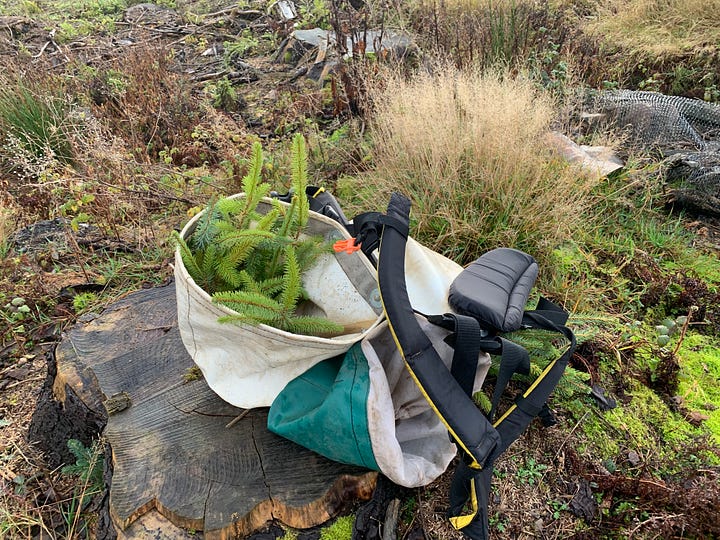
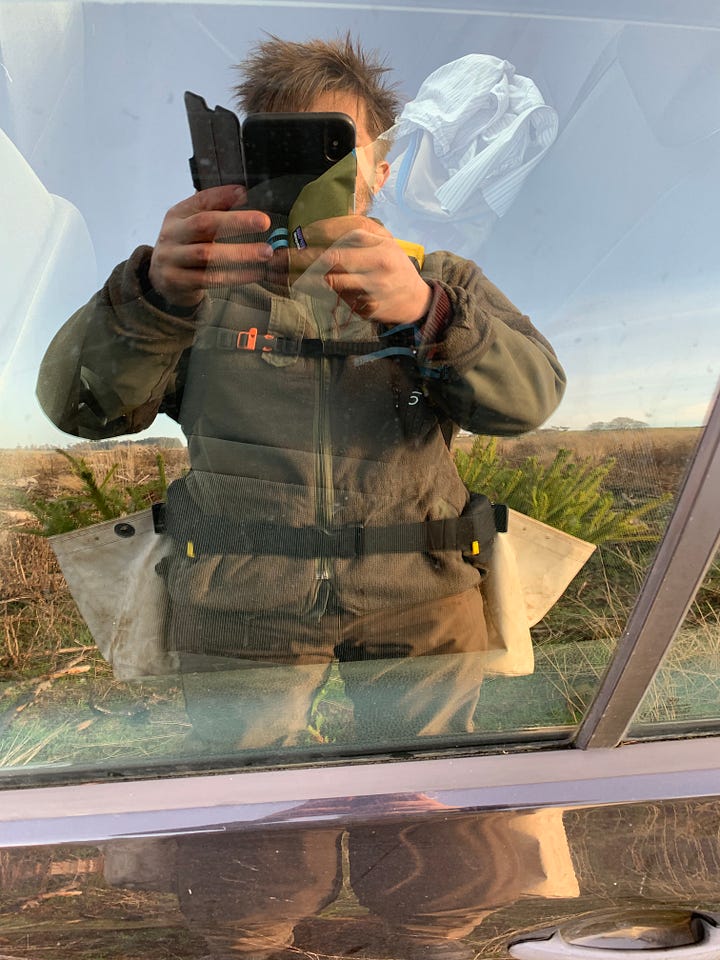
My rig is more practical in that I have the spade and all my tools. But next year, I’m going to pimp it to hold trees, stakes and tubes.
If you were wondering, this is what a pack of ten oaks looks like. I have six packs of 10 left. Mrs Treesandcode will be pleased to once again have a clear front of house. “Pallet full of trees chic” isn’t going to catch on as this seasons must-have home decor.
Rabbit Tubes?
The elephant in the room. I got these trees for free from Carbon Footprint. They are one of those companies that does carbon offsetting in the form of “your companies carbon footprint is X, therefor you need to plant Z trees”. Had I paid for these trees, I would have paid about £1000~ for the trees. Ideally I would have received oak stakes and 1.2m deer tubes. This would have put the total up by £2500~. Rabbit tubes with canes however, probably put the total up by £1000. Can you figure out why I was supplied with rabbit tubes rather than deer tubes? I’m not looking a gifthorse in the mouth however, and I am very grateful for the trees. Especially since we got cells (more expensive, heavier to transport, more likely to survive planting) and not bare root (cheaper, lighter and less likely to survive planting).
Luckily for now, the trees are small and thus protected by the 60cm rabbit tubes, but as soon as the trees grow beyond the top of the tube, the deer will browse them. So what I am going to do to stop the deer. Well first I’m going to treat them with Trico Deer Repellant. I’ve heard good things about it, and it’s based on lamb fat - which deers hate. I’ll be using this on all of the hazel. As for the oaks - I have managed to liberate a few hundred 1.2m deer tubes but I don’t have any stakes. Whilst hazel isn’t known for its longevity when used as a post, I have lots of overstood hazel that needs to be used for something. My current plan is to cut up the large stems of overstood hazel into 1.8m lengths and rive them into stakes, use an axe to point the ends and “whack em in the ground”. I’ve certainly got enough to get this done.
Next time though, I’ll make sure to get the deer tubes. Re-tubing 300 oaks is a pain in the anus.
Long Road
There’s a long road between this years planting and having the woodland up and running as a functioning coppice with standards. However, the reality is that this is treeworld and things are slow. I’m nearly fifty and even if I live until I’m hundred and able to get into the woodland (life goals) any oaks I plant this year will still be considered “early mature”. Hell, they won’t even produce acorns until I’m between 70 & 80.
But they say “the best time to plant a tree was twenty years ago and the next best time is today”. That’s what I’ve been doing. Starting the slow process of returning this woodland into a state which will give me a sustainable source of hazel and oak from which to work with. No rush. Years matter in treeworld, milliseconds matter in techworld. However, no matter how much code you write, nothing, and I mean nothing comes close to pulling a drawknife over green timber and shaping your own harvested stuff into a thing.
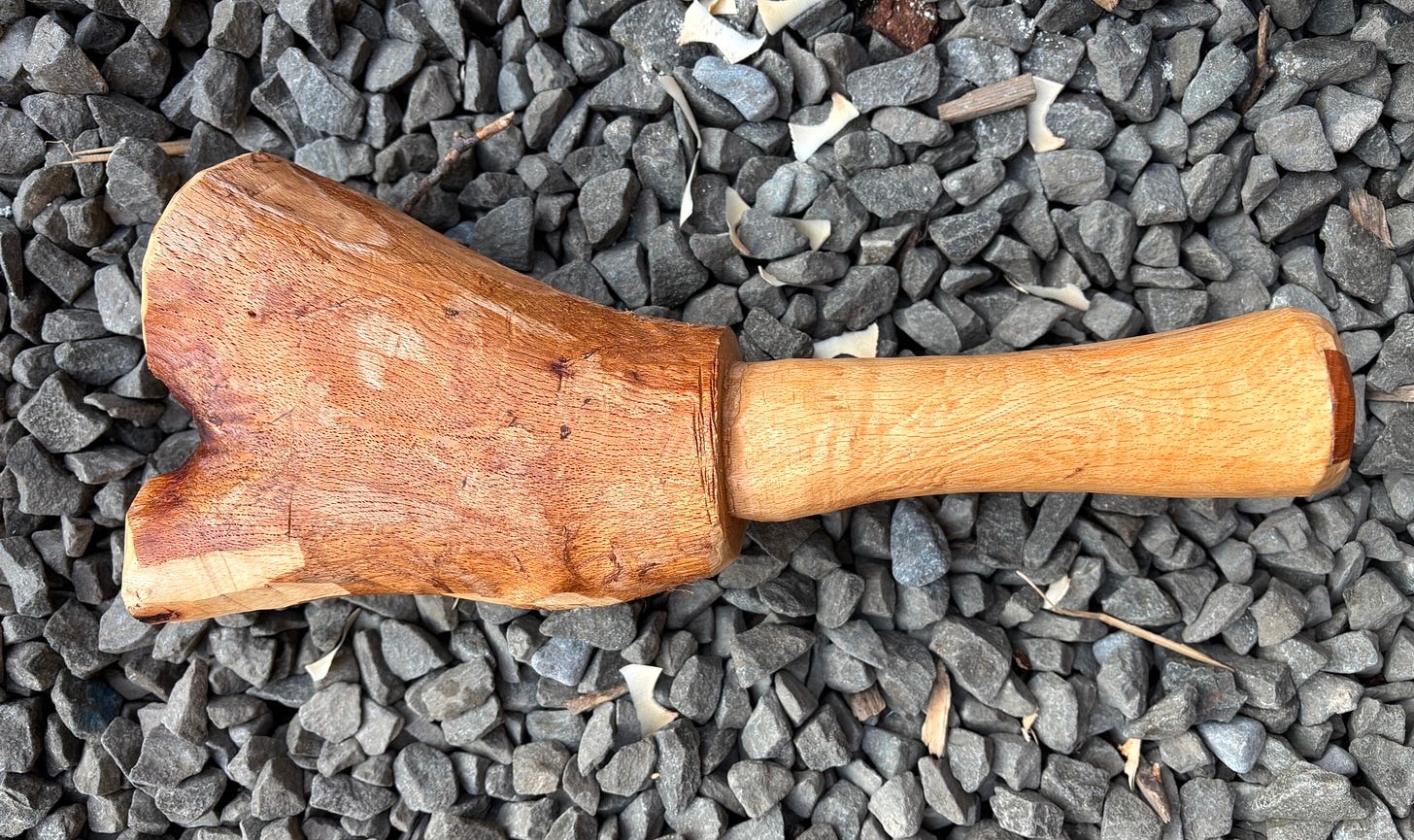
In terms of the woodland and the jobs I’m tackling, I’m torn between fixing drainage or securing the perimeter from motorbikes with dead hedges. They’ve been getting in the front through the stone path I laid down, so I installed a woodland gate.
That’s the thing with a woodland, there is an endless list of things to do. Even if you turn up with a plan, the woodland has a schedule all of its own. I think the drainage is going to win.
I have no idea what I’ll do next, but I know I’ve still got 60 oaks left to go.
Alright, that’s a wrap. Thanks for reading.
I appreciate your attention.
Cheers,
Jamie.


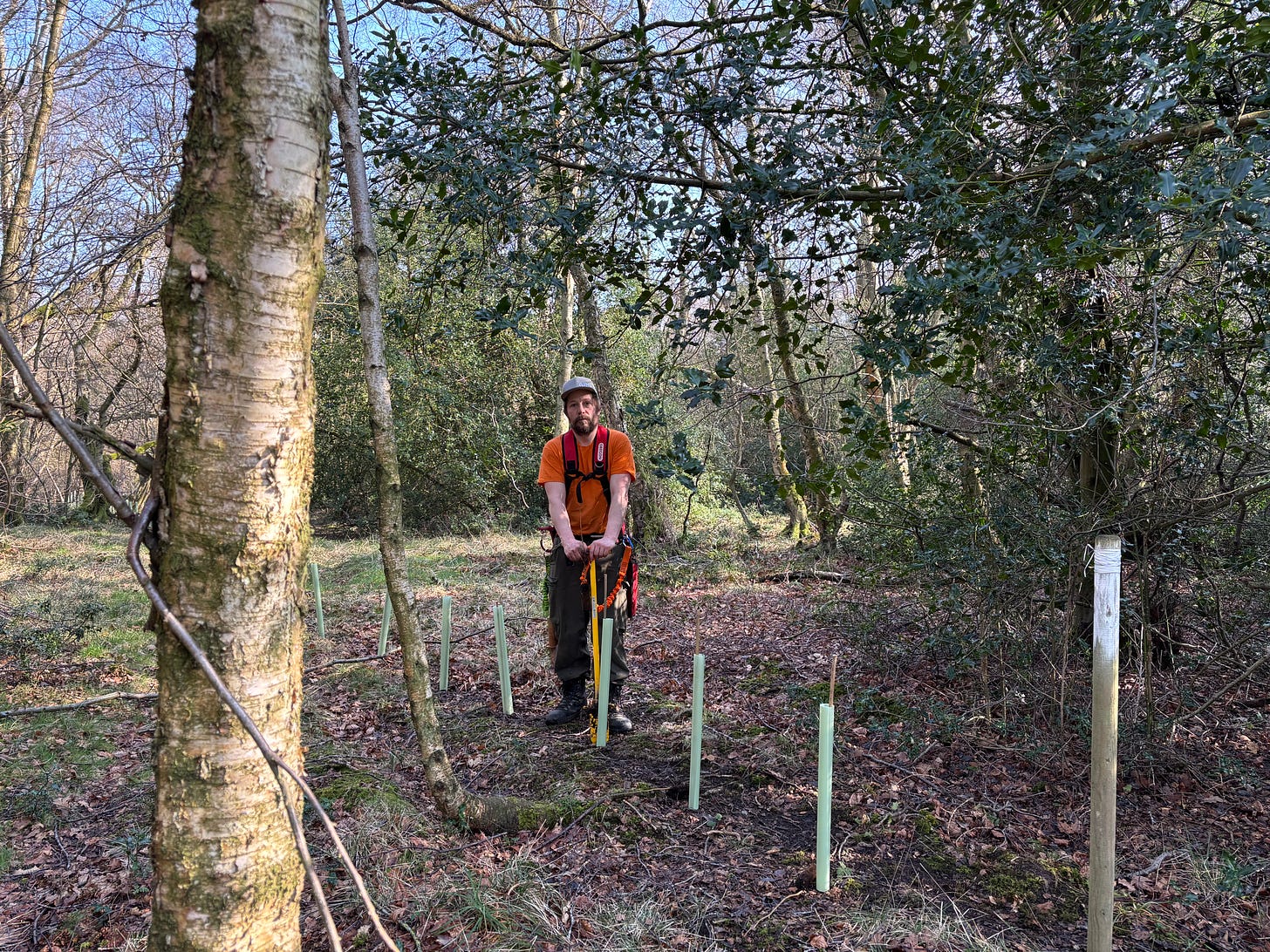
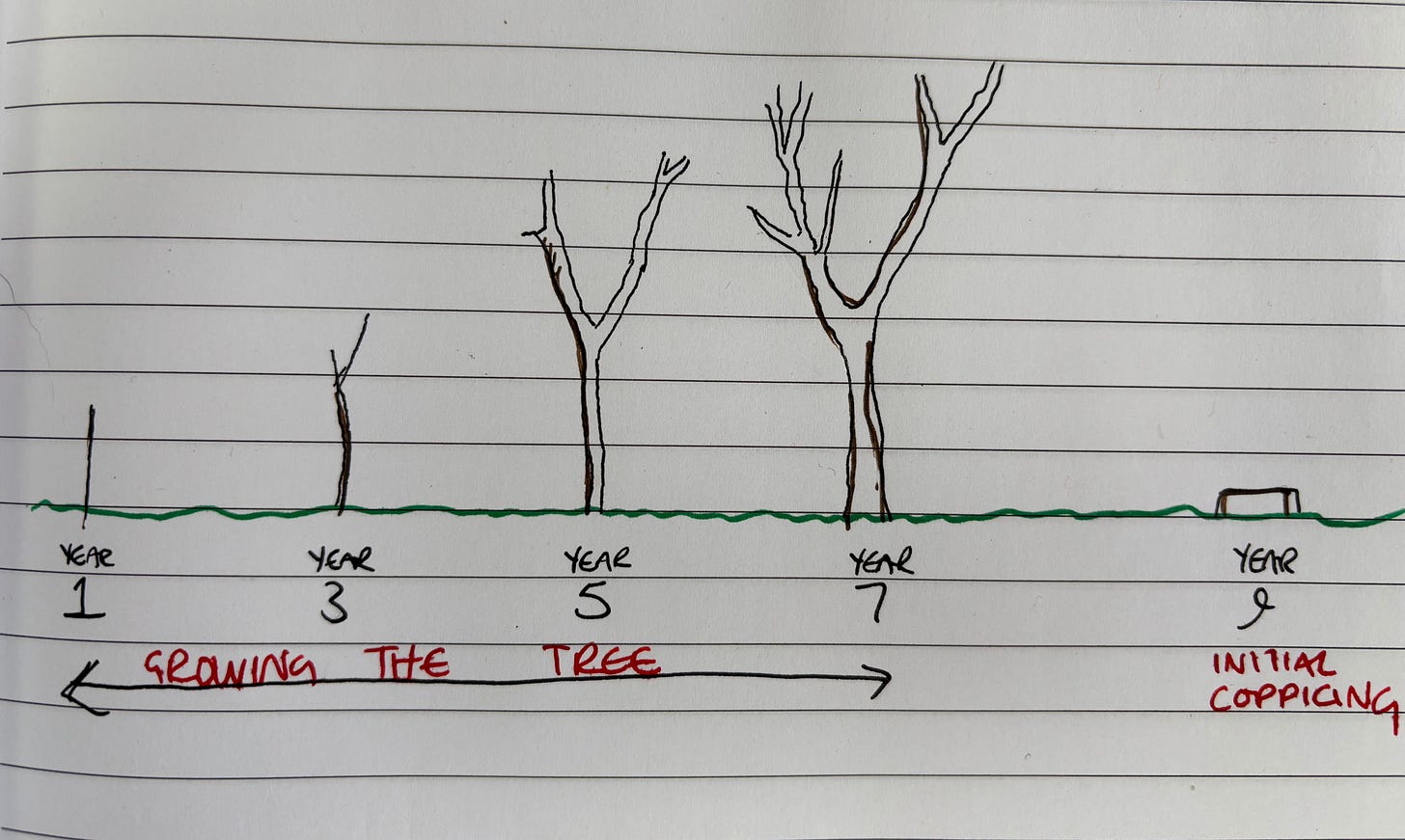
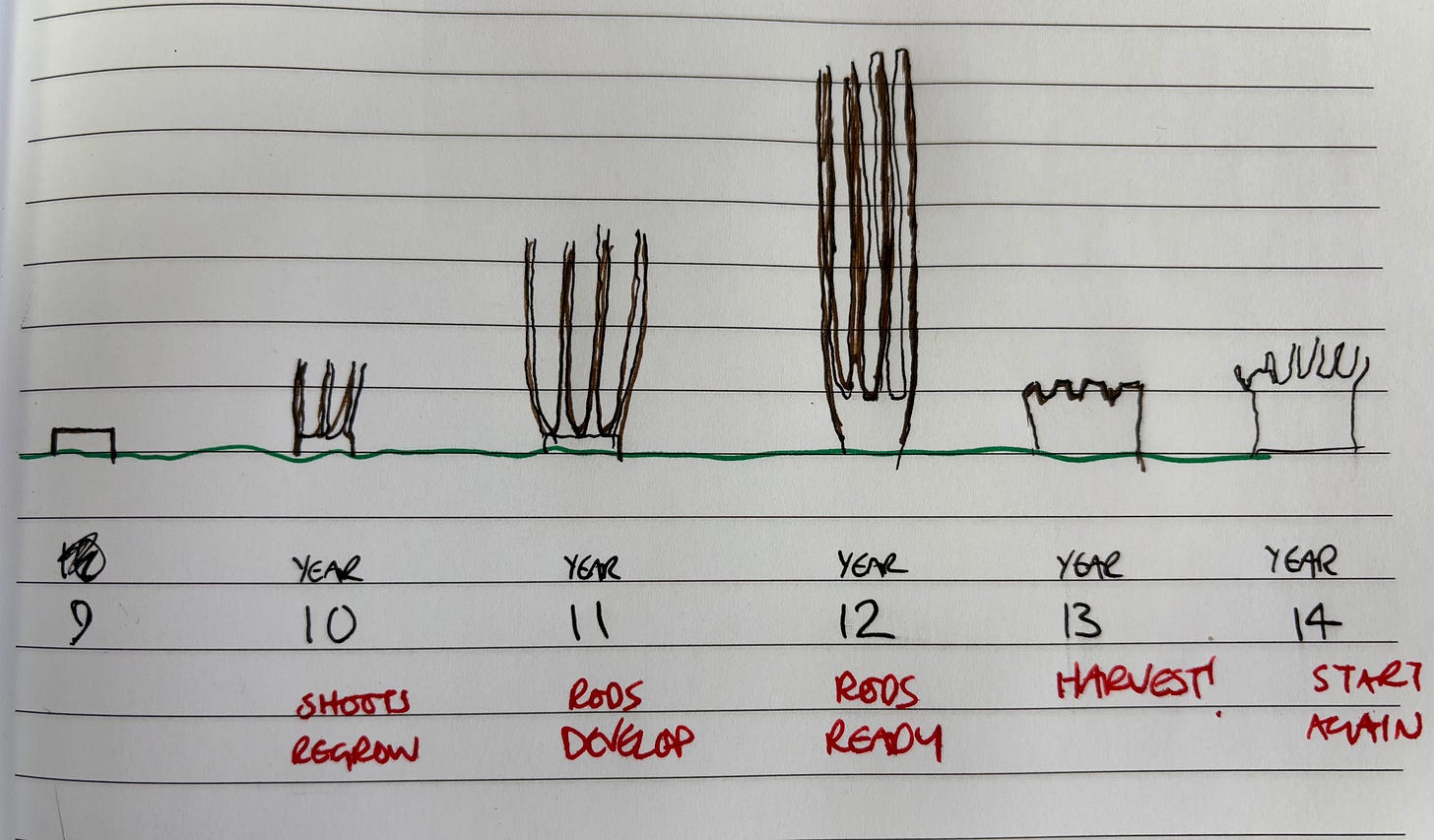

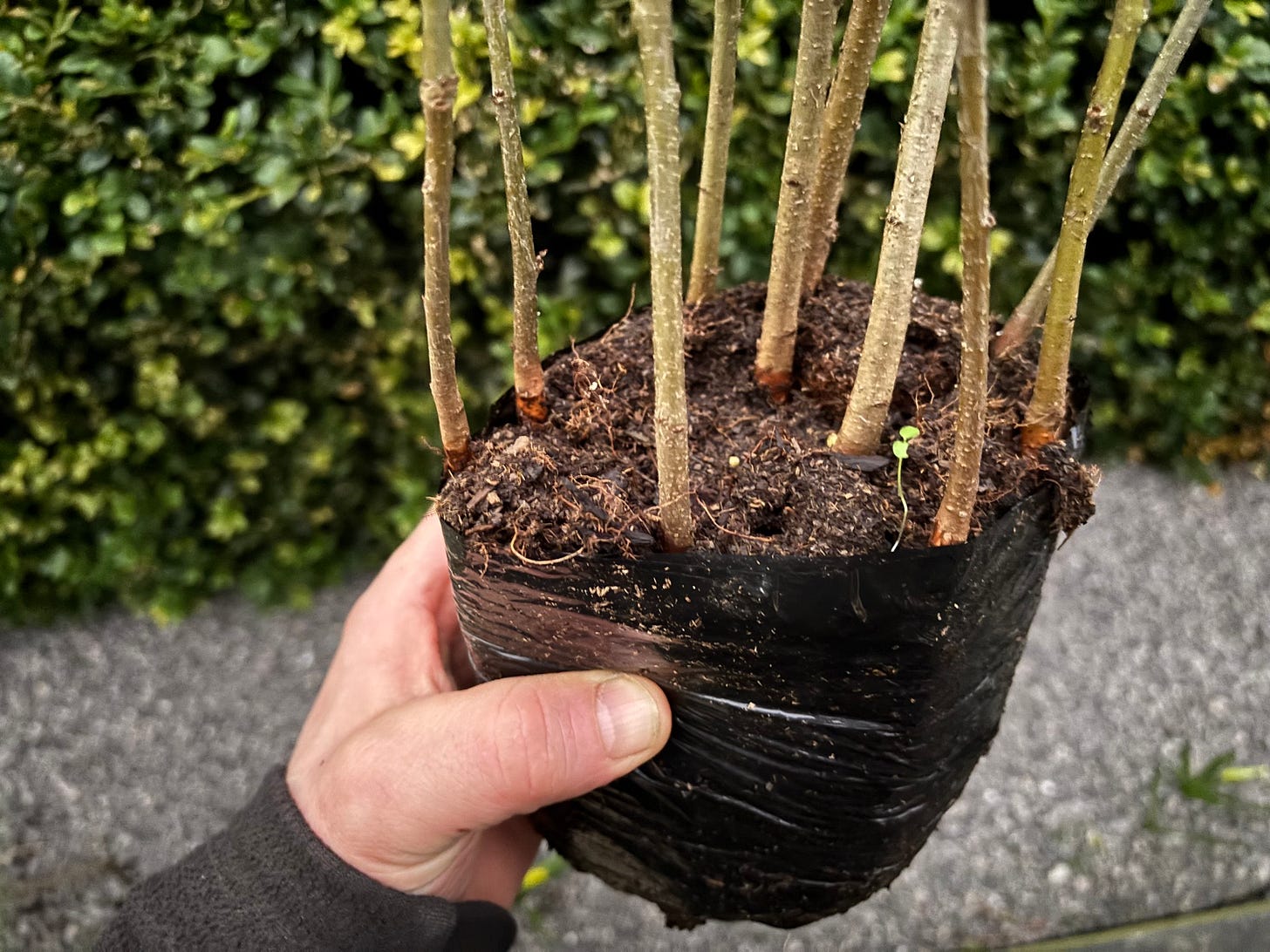
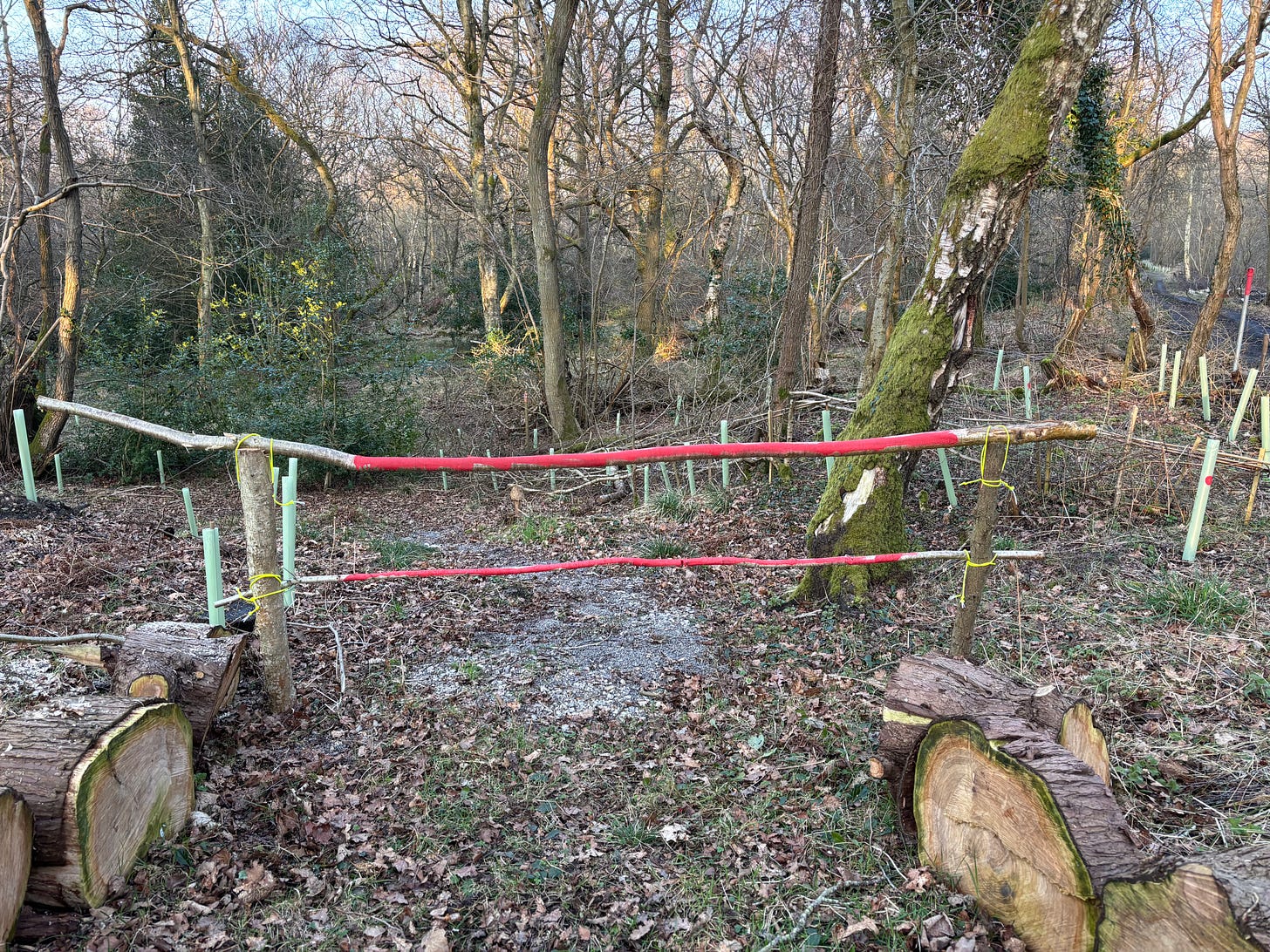
I have a solution for both your deer- and motorbike problems: landmines. I have connections in Ukraina and can get you a pallet delivered quayside on the Tyne, no paperwork, no questions, special price for you my friend.
Good to see you back in your own woods again :-)